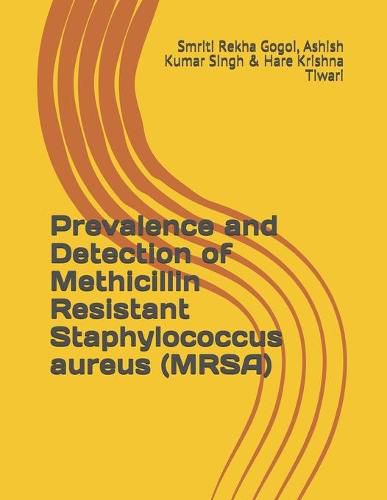Readings Newsletter
Become a Readings Member to make your shopping experience even easier.
Sign in or sign up for free!
You’re not far away from qualifying for FREE standard shipping within Australia
You’ve qualified for FREE standard shipping within Australia
The cart is loading…






Methicillin-resistant Staphylococcus aureus (MRSA) is a major nosocomial pathogen causing significant morbidity and mortality. The epidemiology of MRSA has continued to evolve since its first appearance more than three decades ago. Epidemic strains of these MRSA are usually resistant to several other antibiotics. During the past 15 years, the appearance and worldwide spread of many such clones have caused major therapeutic problems in many hospitals as well as the diversion of considerable resources to attempts at controlling their spread.It has been seen that the increasing prevalence of MRSA infections in the hospitals, other care centers and in the community has become a worldwide phenomenon. The widespread of the multi-drug resistant strains and the antibiotic clones of the bacteria is worrying as it complicates the diagnosis and chemotherapies. There is a need for the adequate policy framework on infection control that will reflect the current epidemiologic characters of MRSA as well as the strict implementation of such control program to checkmate the spread of MRSA infections. MRSA and now vancomycin resistance has also resulted in a steady decline in efficacy of these antibiotics. MRSA is no longer only an infection that is acquired in hospitals (HA-MRSA), although this remains a primary source of transmission. The incidence of HA and CA-MRSA infections as well as their prevalence varies considerably among countries. Some of the MRSA clones lineages are more frequently isolated than others owing to their survival and transmissibility. The HA-MRSA is endemic in many hospitals worldwide. The MRSA has markedly influenced the empirical therapy for Staphylococcal infections. Limited therapeutic options are available for the management of these infections. Most -lactam antibiotics are ineffective against both HA and CA-MRSA. The HA-MRSA is usually MDR. Resistance to -lactam drugs varies geographically and may change over time. The infections were treated with oral antibiotics including doxycycline, minocycline, clindamycin, trimethoprim-sulfamethoxazole, rifampicin and fusidic acid. Severe HA-MRSA infections demand intravenous vancomycin therapy. Transmission can be prevented by following infection control strategies and decolonization therapy. The key to MRSA control is the early treatment of MRSA infections and the following of good infection control practices. As only limited drugs are available for the treatment of MRSA, irrational use of antibiotics should be avoided and a rational antibiotic policy must be adopted.
$9.00 standard shipping within Australia
FREE standard shipping within Australia for orders over $100.00
Express & International shipping calculated at checkout
Methicillin-resistant Staphylococcus aureus (MRSA) is a major nosocomial pathogen causing significant morbidity and mortality. The epidemiology of MRSA has continued to evolve since its first appearance more than three decades ago. Epidemic strains of these MRSA are usually resistant to several other antibiotics. During the past 15 years, the appearance and worldwide spread of many such clones have caused major therapeutic problems in many hospitals as well as the diversion of considerable resources to attempts at controlling their spread.It has been seen that the increasing prevalence of MRSA infections in the hospitals, other care centers and in the community has become a worldwide phenomenon. The widespread of the multi-drug resistant strains and the antibiotic clones of the bacteria is worrying as it complicates the diagnosis and chemotherapies. There is a need for the adequate policy framework on infection control that will reflect the current epidemiologic characters of MRSA as well as the strict implementation of such control program to checkmate the spread of MRSA infections. MRSA and now vancomycin resistance has also resulted in a steady decline in efficacy of these antibiotics. MRSA is no longer only an infection that is acquired in hospitals (HA-MRSA), although this remains a primary source of transmission. The incidence of HA and CA-MRSA infections as well as their prevalence varies considerably among countries. Some of the MRSA clones lineages are more frequently isolated than others owing to their survival and transmissibility. The HA-MRSA is endemic in many hospitals worldwide. The MRSA has markedly influenced the empirical therapy for Staphylococcal infections. Limited therapeutic options are available for the management of these infections. Most -lactam antibiotics are ineffective against both HA and CA-MRSA. The HA-MRSA is usually MDR. Resistance to -lactam drugs varies geographically and may change over time. The infections were treated with oral antibiotics including doxycycline, minocycline, clindamycin, trimethoprim-sulfamethoxazole, rifampicin and fusidic acid. Severe HA-MRSA infections demand intravenous vancomycin therapy. Transmission can be prevented by following infection control strategies and decolonization therapy. The key to MRSA control is the early treatment of MRSA infections and the following of good infection control practices. As only limited drugs are available for the treatment of MRSA, irrational use of antibiotics should be avoided and a rational antibiotic policy must be adopted.